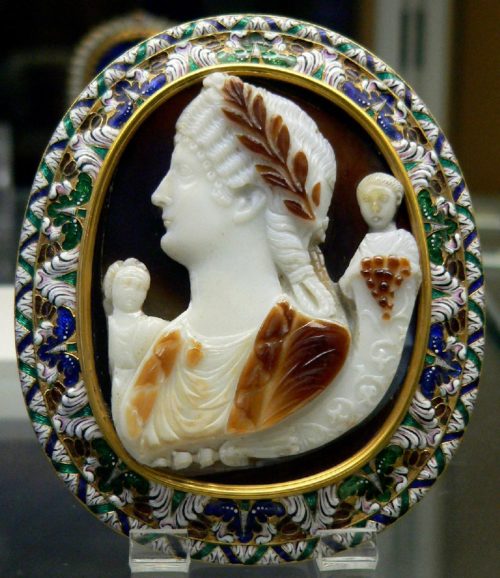
The attitude to pearls has been special since the time of the New World – it seems to be the same jewel as diamonds, emeralds and rubies, but, unlike them, pearls are “alive”. These mysterious “pieces”, extracted from the depths of water, like tiny aliens, excited the imagination and caused a real “pearl fever” among rich people, driving them crazy. Perhaps most accurately all the charm of pearls is conveyed in the figures of the Renaissance …

The popularity of pearls. Fantasy
Women riding seahorses, salamanders swallowing emeralds, pagan gods, monkeys – the structure and shape of pearls inspired the authors of those years. Jewelers call such pearls baroque – they do not have an ideal round shape, resembling silhouettes of living creatures or objects in outline, depending on the master’s imagination.
Sometimes pearls were a separate decoration, but often they became the bodies of fantastic creatures.
Many of these masterpieces are due to the rise of humanism during the Renaissance. Combined with the freedom and openness of Renaissance art, he gave us these amazingly grotesque hybrid pendants that began to appear all over Europe and quickly gained popularity.

The most famous of this batch in the jewelry world is The Canning Jewel pendant (1560).
This Baroque Renaissance sculptural piece includes a large pearl combined with gold, enameled colored gemstones and diamonds to form a bearded sea king with a scimitar in his right hand and a dragon mask in his left.
The pendant got its name in honor of the former owner – Charles John Canning, known as Viscount Canning, who was the Governor General of India from 1856 to 1861. It was a turbulent period in the history of India, during which there was the first organized uprising against British rule or, as the local population called it, the First War of Independence from Great Britain.

The exquisitely crafted sculptural pendant, a monument to the ingenuity and skill of an unknown Renaissance jeweler, was believed to have been acquired by Viscount Canning while serving in India. How he got to Canning is not known for certain. The pendant could be presented to the viscount, bought by him from its owner, or confiscated by the viscount by virtue of the powers granted to him as governor-general and queen’s representative in British colonial India.

Medicine or symbol of unprecedented wealth?
Unfortunately, such jewelry is somewhat outside our price range: today such a stone will sell for more than half a million dollars. And in the old days it was an unprecedented luxury.
After the crusaders brought pearls to Europe, during the Middle Ages, up to the 19th century, it was believed that it has healing qualities and gives the wearer spiritual strength, especially good at curing melancholy. Pearls were dissolved in vinegar, a little milk and honey were added – and now, as if by magic (and, most likely, thanks to the power of suggestion), the sufferer immediately began to feel “in combat form.”

Queen Elizabeth I especially loved wearing pearl jewelry. Even when she died, she was buried with pearl medallions on her shoes (during her lifetime she wore them to demonstrate her strength and power).
The trade with Italy, which abounded with artisans in gold and pearl jewelry, peaked in the 1400s and opened up demand among wealthy people across Europe. Pearls have retained their popularity for several centuries.
Acquaintance of Europeans with this incredible jewel marked the beginning of the “Pearl Age”, in which such jewelry was so popular that the elite began to pass laws regulating who has and who has no right to wear them in the highest circles of society. For many people, pearls became a form of currency that could be used for various purposes – medical, spiritual, aesthetic. In a sense, these were the “bitcoins of the Renaissance”.

“Pear” at the cost of $ 40 million
In the 16th century, a Spanish slave dug a stunning pear-shaped pearl in the depths of the Gulf of Panama, which the Queen of Spain named La Peregrina. The jewel was so large and magnificent that for its discovery the slave was released.
Over the centuries, the relic has changed many very titled owners and, finally, in 1969, actor Richard Burton bought it at Sotheby’s to give his wife, the legendary actress Elizabeth Taylor, on Valentine’s Day.

Due to its high weight, in its entire history, “Peregrina” has repeatedly fallen out of the frame. However, she was invariably found. There is a well-known story about how once Elizabeth Taylor discovered the missing pearl in a hotel room and, after a desperate search, found it … in the mouth of her puppy.
By the way, modern American experts estimate the pearl that the dog chewed so easily at $ 40 million.
Alas, in the 20th century, pearls began to rapidly lose their popularity, and it has not yet been possible to restore it. The reason was, first of all, the flooding of the jewelry market with cultured pearls.
Perhaps, in our time, pearls can regain their former interest on the part of society only with the help of the revival of that Renaissance art, which only the masters of the Renaissance were capable of. If their modern followers manage to create equally outlandish masterpieces from randomly found natural pearls, there is no doubt that they will be valued just as highly.

In the meantime, we can only admire the ancient relics.







